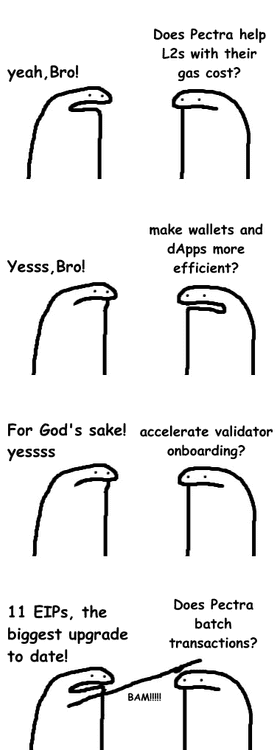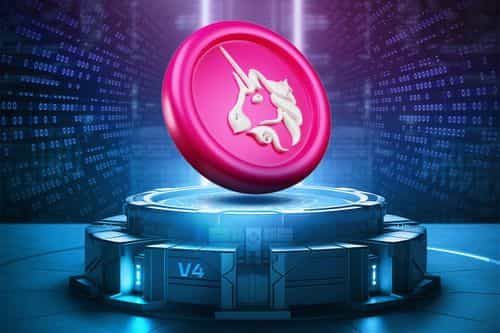Ethereum Pectra Upgrade


Get ready for Ethereum's most ambitious upgrade yet, Pectra, launched on May 7, 2025, is set to revolutionize the network! With 11 game-changing Ethereum Improvement Proposals (EIPs), Pectra enhances scalability, security, and user experience. It accelerates validator operations, increases staking limits, and optimizes layer-2 rollups to reduce transaction costs. Account abstraction brings programmable wallets, transforming how users interact with Ethereum. This upgrade positions Ethereum for the next phase of decentralized innovation. Now, read the full breakdown below.
TL;DR
The Ethereum Pectra upgrade combines 11 EIPs, addressing validator efficiency, layer-2 scalability, and account abstraction. Key changes include faster validator deposits, increased staking limits, and improvements for dApps.
Go ahead and read the wrapped-up key points:
Technical Aspects
The Pectra upgrade is a dual-layer enhancement, targeting both Ethereum’s execution layer (where smart contracts and dApps run) and consensus layer (which manages Proof-of-Stake). Its 11 EIPs address a wide range of technical challenges, from validator efficiency to layer-2 scalability. Below, we break down the key EIPs and their implications.
Key EIPs and Their Functions
Introduces precompiles for BLS12-381 cryptographic operations, commonly used in zero-knowledge proofs.
Impact: Reduces gas costs for cryptographic tasks, benefiting dApps like zk-rollups.
Stores historical block hashes in the blockchain state, improving data accessibility for smart contracts.
Impact: Enhances smart contract functionality for applications requiring historical data.
Moves validator deposits to an on-chain queue, reducing activation time from ~12 hours to ~13 minutes.
Impact: Accelerates validator onboarding, encouraging more participation.
Allows validators to trigger withdrawals via the execution layer, supporting up to 8 withdrawals per block.
Impact: Improves staking flexibility, making it easier for validators to manage funds.
Raises the validator staking cap from 32 ETH to 2,048 ETH, allowing consolidation of multiple validator instances.
Impact: Simplifies validator operations and reduces network overhead.
Optimizes attestation aggregation by restructuring committee indices.
Impact: Lowers bandwidth and processing demands for validators.
Raises the gas cost of calldata to prevent network spam and optimize transaction pricing.
Impact: May increase costs for data-heavy dApps, requiring optimization.
Standardizes communication between execution and consensus layers for deposits and withdrawals.
Impact: Streamlines inter-layer operations, improving network efficiency.
Increases the number of blobs (data packets for layer-2 rollups) per block from a target of 3 to 6 (max 6 to 9).
Impact: Boosts layer-2 scalability, potentially lowering transaction fees.
Enables Externally Owned Accounts (EOAs) to temporarily act as smart contracts, supporting account abstraction.
Impact: Allows advanced wallet features like batch transactions, sponsored gas, and social recovery.
Enhances blob storage management by including schedules in execution layer configurations.
Impact: Improves data handling for layer-2 solutions.

Technical Implication
The technical complexity of implementing 11 EIPs simultaneously makes Pectra the most ambitious Ethereum upgrade to date. Developers and node operators must ensure their systems are ready to handle these changes.
Ecosystem Impacts and Benefits
The Pectra upgrade profoundly impacts the Ethereum ecosystem, enhancing scalability, security, and user experience while delivering tangible benefits to developers, users, and validators. By addressing longstanding
Enhanced Scalability:
Improved Security and Decentralization:
Revolutionary User Experience via Account Abstraction:
Batch Transactions: Bundling actions (e.g., approving and swapping tokens) into one transaction to save gas.
Sponsored Gas: dApps can cover fees, easing onboarding for non-crypto users.
Social Recovery: Recover lost keys using trusted contacts, reducing fund loss risks.
Native Multi-Signature Wallets: Enhanced security without complex setups.
Developer Efficiency and Innovation:
Cost Optimization:
These enhancements align with Ethereum’s long-term roadmap, including sharding and Verkle trees, ensuring sustained scalability and efficiency. By fostering a vibrant ecosystem, Pectra solidifies Ethereum’s position as the leading smart contract platform.
Challenges of the Pectra Upgrade
Despite its promise, Pectra faces several challenges that could impact its success:
-
Implementation Complexity: With 11 EIPs, Pectra is Ethereum’s most complex upgrade to date. Coordinating changes across execution and consensus layers increases the risk of bugs or delays.
-
Compatibility Issues: EIP-7623’s increased calldata costs may raise expenses for data-heavy dApps, requiring optimization. Account abstraction may necessitate wallet and dApp updates.
-
Testing Risks: Testnet deployments on Holesky and Sepolia encountered configuration issues, prompting extended testing windows. A smooth mainnet experience requires rigorous monitoring.
-
Community Education: Features like account abstraction require user and developer education to ensure adoption. Without clear documentation, these enhancements may be underutilized.
-
Client Diversity Concerns: A June 2024 report highlighted risks from low client diversity, noting that a bug in a dominant client could destabilize the network.
-
Adoption Lag: Benefits may take time to materialize as wallets, dApps, and users adapt to new standards.
Addressing these challenges requires collaboration between Ethereum’s core developers, node operators, dApp developers, and the community.
Developer Preparation: Getting Ready for Pectra
Developers play a critical role in ensuring a smooth transition to Pectra. Below, we outline actionable steps to prepare dApps and smart contracts, along with considerations for leveraging new features.
Steps for Developers
- Stay Informed:
- Test on Testnets:
- Update Smart Contracts:
- Check for Breaking Changes:
- Educate Users:
- Monitor Post Mainnet:
Impact on Existing dApps and Smart Contracts
Conclusion
The Ethereum Pectra upgrade, which took place on May 7, 2025, is a transformative milestone, introducing 11 EIPs to enhance Ethereum’s scalability, security, and user experience. By optimizing layer-2 rollups, streamlining validator operations, and enabling account abstraction, Pectra strengthens the ecosystem and delivers benefits like lower fees, improved UX, and developer efficiency. These advancements position Ethereum to compete with high-throughput blockchains while maintaining its decentralized ethos.
However, Pectra’s complexity and potential compatibility issues demand careful preparation. Developers must test on testnets, update smart contracts, and educate users to ensure a smooth transition. Challenges like implementation risks and client diversity concerns require community collaboration to overcome. With thorough preparation, Pectra can unlock Ethereum’s full potential, driving innovation and adoption in the Web3 era.
Resources
Frequently asked questions
Check out most commonly asked questions, addressed based on community needs. Can't find what you are looking for?
Contact us, our friendly support helps!
What is Ethereum’s Pectra upgrade?
Pectra is a significant Ethereum upgrade took place on May 7, 2025, combining the Prague (execution layer) and Electra (consensus layer) updates. It introduces 11 EIPs aimed at enhancing scalability, security, and user experience.
How does EIP-7702 improve Ethereum wallets?
EIP-7702 introduces account abstraction, allowing Externally Owned Accounts (EOAs) to execute smart contract code. This enables features like batch transactions, sponsored gas fees, and social recovery, enhancing wallet functionality.
What are the benefits of EIP-7691 for Layer 2 solutions?
EIP-7691 increases the blob throughput per block, allowing more data to be processed efficiently. This enhancement benefits Layer 2 solutions by reducing transaction fees and improving scalability.



